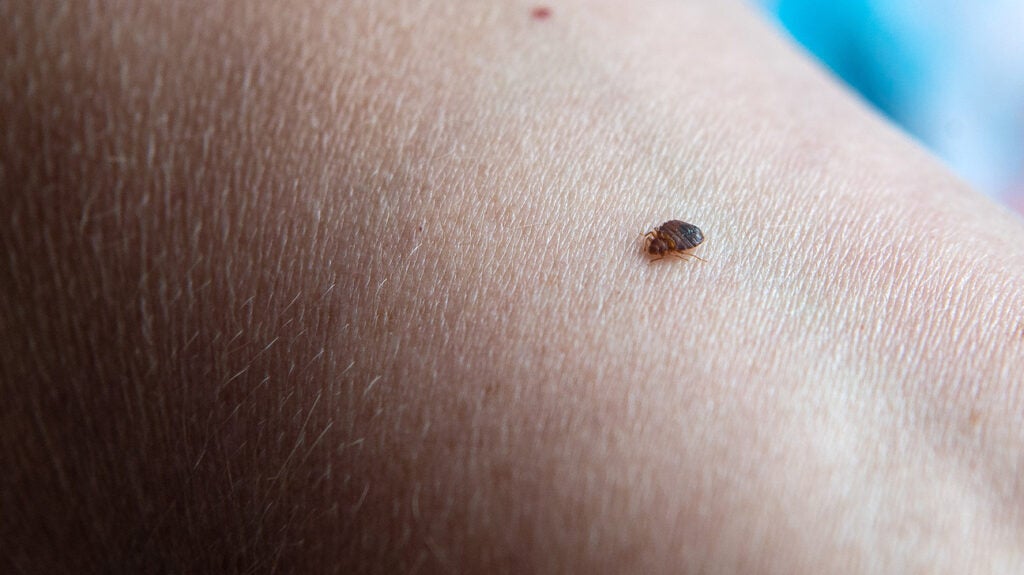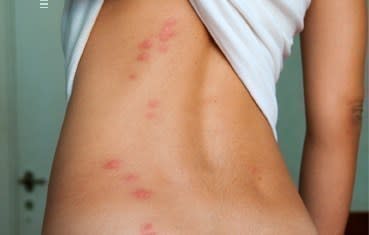After being exposed to bed bugs, symptoms can appear within a few hours to a few days. It is crucial to act promptly to prevent infestations.
Bed bugs are parasitic insects that feed on human blood, causing discomfort and potential health risks. Knowing the timeline for symptoms after exposure is essential for prompt identification and treatment. We will explore the period it takes for bed bug symptoms to manifest after exposure.
Understanding this timeline can help individuals take necessary steps to address a bed bug issue before it worsens. Let’s delve into the details of how long it typically takes for symptoms to show after encountering bed bugs.

Credit: www.medicalnewstoday.com
Identifying Bed Bug Bites
Appearance Of Bed Bug Bites
Bed bug bites appear as small, red, itchy welts on the skin, often in clusters. These bites may resemble mosquito bites or a rash, but they typically have a linear pattern. The bites can vary in size and shape, depending on how the individual reacts to them.
Common Locations Of Bed Bug Bites
Bed bugs commonly bite exposed areas of the body while you’re sleeping, such as the face, neck, arms, and hands. They are drawn to areas with thin skin that are easily accessible for feeding. However, bites can appear on any part of the body, especially in severe infestations.
Symptoms Of Bed Bug Bites
Physical Symptoms
Bed bug bites are typically small, red, and itchy bumps that appear in a cluster or line.
Allergic Reactions
In some cases, people may experience severe allergic reactions to bed bug bites.
Timeline Of Bed Bug Bites
After exposure to bed bugs, the timeline of bed bug bites can vary. Typically, bites appear within 1-14 days. Some may react immediately, while others show delayed reactions. Monitoring for bites is crucial after suspected exposure.
Understanding the timeline of bed bug bites is crucial for assessing and addressing the situation effectively. Bed bugs, pesky little creatures that they are, can leave behind intensely itchy bites that can drive anyone crazy. However, the timing of these bites can vary depending on several factors, including an individual’s reaction to the bite and the severity of the infestation.
Immediate Reaction
For some people, the immediate reaction to a bed bug bite can be both alarming and uncomfortable. Upon being bitten, individuals may experience immediate redness, swelling, and itchiness in the affected area. These bites tend to be more visible on individuals with lighter skin tones.
Important: It is worth noting that not everyone reacts immediately to bed bug bites. Some individuals may have little to no visible reaction, making it difficult to identify an infestation solely based on skin irritations.
Delayed Reaction
Unlike the immediate reaction, delayed reactions to bed bug bites may not become apparent until hours or even days after being bitten. These delayed reactions can manifest as clusters of itchy red bumps or welts on the skin, similar to that of a mosquito bite. The severity of the reaction may vary from person to person, with some experiencing mild discomfort and others facing intense itching and inflammation.
Furthermore, it is important to note that bed bug bites may not show up in the same location each time. They can appear on different parts of the body, making it even more difficult to recognize and trace their source.
Remember: It is essential to consult a medical professional if you suspect bed bug bites or if the itching and discomfort persist or worsen over time. A professional pest control expert should also be contacted to address the bed bug infestation, as self-treatment may not effectively eliminate the problem.

Credit: www.researchgate.net
Factors Affecting Reaction Time
Reaction time to bed bug exposure varies based on factors like individual sensitivity, infestation level, and cleanliness. In some cases, symptoms may appear immediately, while in others, it could take days or even weeks to notice a reaction.
Factors Affecting Reaction TimeIndividual SensitivityThe individual’s sensitivity to bed bug bites plays a vital role in determining how quickly they may react. Some people may experience immediate symptoms, while others may take a longer time to notice any signs of bed bug exposure.Number of Bed BugsThe number of bed bugs present in an environment can significantly impact the time it takes for an individual to react. A higher infestation can lead to more frequent bites, increasing the chances of symptoms appearing sooner.Duration of ExposureThe duration of time spent in an infested area is a crucial factor. Extended exposure can result in a quicker onset of symptoms, while shorter periods may lead to delayed reactions.Environmental ConditionsEnvironmental conditions, such as temperature and humidity, can influence reaction time. Warmer and more humid environments can expedite the onset of symptoms, while cooler and drier conditions may slow down the reaction process.Treatment For Bed Bug Bites
When it comes to treating bed bug bites, the focus is on alleviating the discomfort and itching caused by these pesky pests. Understanding the various treatment options available can help provide relief and promote faster healing.
Home Remedies
There are several simple and accessible home remedies that can help relieve the itching and discomfort associated with bed bug bites. These include:
- Applying ice packs to the affected area to reduce swelling and itching.
- Using a mixture of baking soda and water as a paste to alleviate itching.
- Applying aloe vera gel to soothe the skin and reduce inflammation.
Over-the-counter Medications
Over-the-counter medications can provide additional relief for bed bug bites, such as:
- Antihistamine creams or lotions to reduce itching and inflammation.
- Hydrocortisone cream to alleviate itching and promote healing.
- Calamine lotion to soothe the skin and reduce discomfort.
Medical Interventions
In severe cases, medical interventions may be necessary to address bed bug bites, which can include:
- Prescription-strength antihistamines or corticosteroids to manage severe itching and inflammation.
- Oral antibiotics if the bites become infected.
- Seeking professional medical advice if the bites are causing severe allergic reactions or persistent discomfort.
Credit: www.businessinsider.com
Preventing Bed Bug Infestations
Bed bugs are an annoyance that nobody wants to deal with. These tiny pests can hitch a ride into your home on your luggage, clothing, or items you bring in from other places. Once they infest your living spaces, they can be incredibly difficult to get rid of. However, there are effective methods you can implement to prevent bed bug infestations from occurring in the first place. By following these strategies, you can safeguard your home and ensure a peaceful night’s sleep.
Regular Cleaning And Vacuuming
Regular cleaning and vacuuming are essential for keeping bed bugs at bay. These pests love to hide in cracks, crevices, and upholstery, so thorough cleaning is crucial. By using a vacuum with a HEPA filter, you can suck up any stray bugs, eggs, or larvae that may be hiding in your home. Don’t forget to pay attention to areas where bed bugs are commonly found, such as mattresses, box springs, bed frames, and bedside furniture.
Inspecting Hotel Rooms
When traveling, it’s important to be vigilant and inspect hotel rooms for any signs of infestation. Bed bugs are known to hide in luggage racks, headboards, and mattresses. Take a few minutes upon arrival to examine these areas carefully. Look out for live bugs, dark spots or stains on bedding and furniture, and shed exoskeletons, which are evidence of an infestation. If you notice any signs, immediately notify the hotel staff and request another room.
Reducing Clutter
Clutter provides the perfect hiding spots for bed bugs, making it essential to declutter your living spaces. Clear out any unnecessary items, particularly in bedrooms, to reduce potential hiding spots. Avoid leaving clothes, bags, or other personal belongings on the floor or in piles. By minimizing clutter, you eliminate potential harborage areas and make it easier to spot and eliminate bed bugs.
Using Mattress Covers
One effective preventive measure is to use mattress covers designed specifically to protect against bed bugs. These covers create a barrier that prevents bed bugs from accessing and infesting your mattress. Make sure the covers you choose are labeled as bed bug-proof and encase the entire mattress, including the zipper. Regularly checking for any tears or damage is also important, as bed bugs can enter through weak spots.
Frequently Asked Questions Of How Long After Exposure To Bed Bugs?
How Long Does It Take For Bed Bug Bites To Show Up?
Bed bug bites may appear within minutes to days, depending on the individual’s reaction. Some may see immediate redness and swelling, while others may not react for several days after being bitten.
What Are The Signs Of A Bed Bug Infestation?
Look for rusty or reddish stains on bed sheets or mattresses, an offensive, musty odor from the bugs’ scent glands, and small, clustered bites that itch. Additionally, you may notice bed bug exoskeletons, eggs, or live bugs in the seams and folds of mattresses.
How To Identify Bed Bug Bites?
Bed bug bites are often clustered or in a line on exposed skin areas such as arms, shoulders, and legs. They appear as red, itchy welts or raised bumps on the skin. Scratching the bites can lead to infection, so it’s essential to avoid scratching them.
Conclusion
To sum up, determining how long it takes for symptoms to appear after exposure to bed bugs can be challenging. The timeframe may vary depending on individual reaction and the level of infestation. It is crucial to promptly address the issue and seek professional help if needed.
Additionally, taking preventive measures such as regularly inspecting and cleaning your living spaces can help minimize the risk of bed bug infestations. Stay vigilant and proactive to ensure a bug-free environment.
Related posts:

I’m MD Tanvir, and I bring years of expertise gained from working closely with pest control companies to the forefront. My journey in the industry has inspired me to launch Bug Battler, a platform aimed at equipping people with the know-how to combat pests autonomously. Through Bug Battler, I aim to empower individuals with practical insights to tackle pest infestations effectively.

